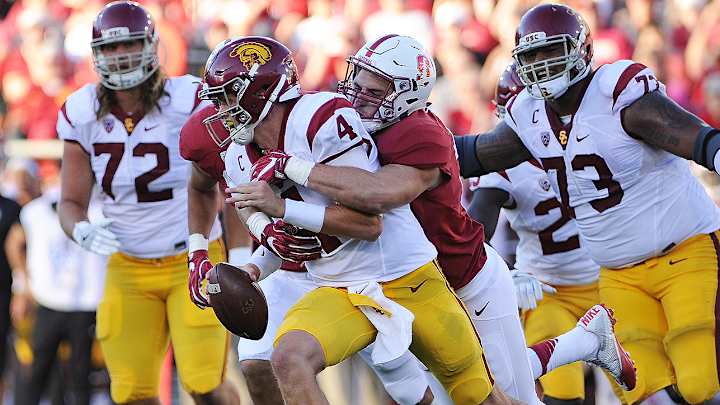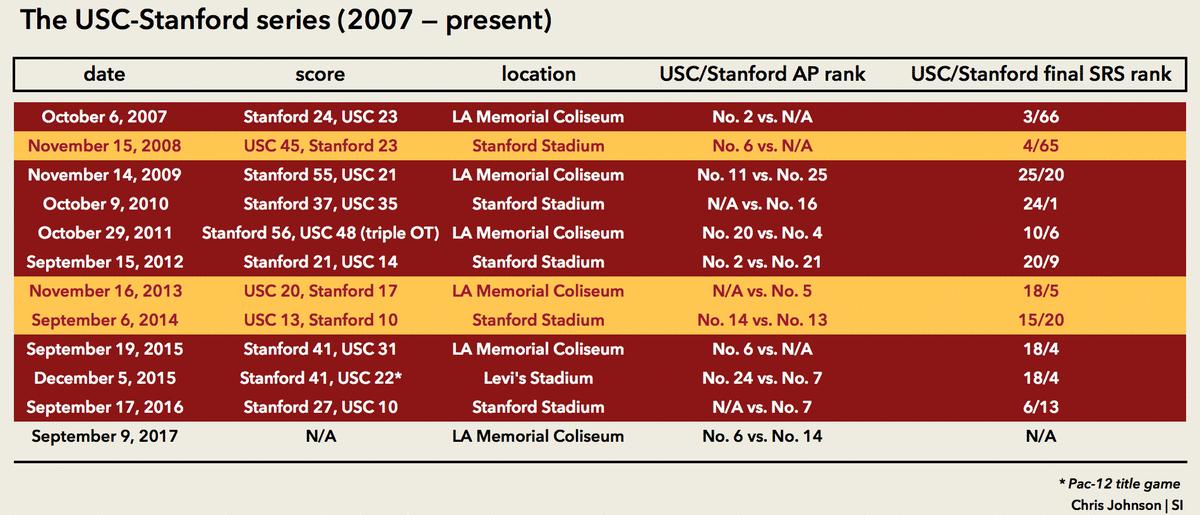USC's Path Back to Perennial Pac-12 Supremacy Runs Through Stanford

The post-Pete Carroll era at Southern California has been defined, more than anything else, by elevated expectations followed by devastating disappointment. There was the 2012 season, which USC opened ranked No. 1 in the AP Top 25 Poll under third-year head coach Lane Kiffin, only to finish 7–6 with a listless 14-point loss to Georgia Tech in the Sun Bowl. Three years later, the Trojans entered Week 1 with a No. 8 ranking but spent most of the season under the charge of an interim coach after firing Steve Sarkisian and posted an 8–6 final record.
That interim coach, Clay Helton, is now USC’s permanent head coach, and he faces a litmus test in his second full season in charge on Saturday, when Stanford visits Los Angeles Memorial Coliseum in a matchup between College Football Playoff contenders. Like the 2012 and ’15 seasons, the Trojans began the ’17 campaign carrying a bandwagon bursting at the seams. Both the preseason AP Top 25 and Coaches Poll placed USC No. 4, and all but one of Sports Illustrated’s college football writers picked it to make a New Year’s Six bowl in our Crystal Ball. If the Trojans weren’t completely “back,” they felt close.
We’re about to find out whether those expectations are overblown, spot-on, inadequate or something in between. USC may not face a better team than Stanford in the regular season, and the Cardinal, to put it simply, have owned the Trojans over the last decade, winning eight of the past 11 meetings between the teams and seven of the past nine. For USC, there would be no stronger signal that it won’t buckle under heavy hype yet again than a convincing victory over a program that has routinely whipped college football’s SoCal blueblood since Carroll left for the NFL.
How Orlando Brown and Sam Hubbard Came to Tip the Scales of Oklahoma vs. Ohio State
Before getting into the particulars of this Saturday’s matchup, it’s worth reviewing how thoroughly the Cardinal have dominated this series since the mid-aughts. The most memorable meeting is still bewildering 10 years after it took place: On Oct. 6, 2007, then-Stanford (and now Michigan) head coach Jim Harbaugh orchestrated a 24–23 win over Carroll-led USC at the Coliseum after entering the game as a 41-point underdog. The Trojans got revenge with a 45–23 victory the next year, but it was all downhill from there: The Cardinal won seven of the next nine meetings, including the last three.
That 2007 stunner may have felt like a one-off in real time given the programs’ histories and recruiting track records, but Harbaugh’s predecessor, David Shaw, has cemented Stanford’s status as a perennial conference title threat and, incidentally, a recurring nightmare for USC. “This is going to be my eighth season at USC,” Helton, a former Trojans assistant, said on the Pac-12 coaches teleconference this week. “And one of the things that comes into play each and every year is you know you’re in for a physical war—a battle with a very good, disciplined Stanford team.”
The chart below shows every tilt between the Cardinal and Trojans since 2007. The acronym SRS stands for Simple Rating System, a Sports-Reference statistic incorporating point differential and schedule strength.

Stanford trucked Conference USA foe Rice, 62–7, in its Week 0 season opener in Australia late last month, while USC went into halftime tied with Western Michigan, one of the top squads in the Mid-American Conference, last week before pulling away for a 49-31 win. The Cardinal definitely looked better than the Trojans in their beatdown of a Group of Five opponent, which helps explain why USC moved down at least one spot in both of the major polls, but more important than the final score of either matchup was how Stanford and the Trojans fared in one particular area: the running game.
A few months after losing all-purpose supernova Christian McCaffrey to the NFL in the first round of the 2017 draft, Stanford rode juniors Bryce Love and Cameron Scarlett to 287 rushing yards and five touchdowns, racking up eight yards per carry. USC yielded 263 yards and two scores on the ground to the Broncos at 5.5 YPC, 1.7 more than it allowed on average against Pac-12 opponents last season. If Western Michigan was able to carve out running lanes for its backs last week, Cardinal offensive linemen might put an I-405-sized hole in the Trojans’ defensive line for Love to burst through.
USC has the advantage at quarterback, with Heisman Trophy frontrunner Sam Darnold besting senior Keller Chryst, and junior tailback Ronald Jones is every bit the grand-slam threat for the Trojans that Love is for Stanford, but USC will need some help on the other side of the ball, particularly if no go-to receiver steps up to fill in for JuJu Smith-Schuster. The Cardinal have lockdown artists in their secondary (junior Quenton Meeks, senior Alijah Holder) and havoc-creators in their front seven (seniors Joey Alfieri and Harrison Phillips) to smother opposing offenses even without No. 3 draft pick Solomon Thomas.
College Football Week 2 Picks: Who Has the Edge in Saturday Night's Busy Slate?
A loss on Saturday would not be crippling for the Trojans. The Pac-12’s still there for the taking, and they could even make a run at the playoff with a second defeat. But not only would both of those things become more difficult with a loss to Stanford, it would be a major setback in the broader context of the Trojans’ quest to regain their status as the league’s clear No. 1. Recapturing the dominant form they enjoyed during Carroll’s heyday may be more aspirational than realistic, but it’s been nearly a decade since they last won the Pac-12. That’s too long, even taking into account the depth-crimping NCAA sanctions levied against the program in 2010.
USC has spent the intervening years rotating coaches, explaining away controversies and flopping in high-leverage games, while Stanford has solidified itself as a consistent force with a clear identity. This is a prime opportunity for the Trojans to beat back the in-state opponent whose rise into a smashmouth powerhouse has coincided with their descent from the Power 5 peak. By getting a W over Stanford, USC can demonstrate that this time, unlike other times over the last decade, there’s some substance beneath the flash.
